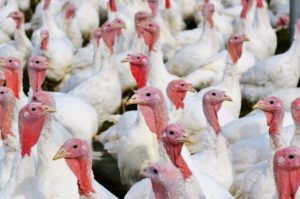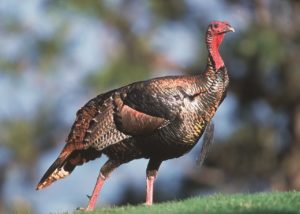 Thanksgiving is just around the corner. Whether you’ve already planned your entire Thanksgiving meal or you’re just starting to think about it, shopping for this traditional meal has become a lot more complicated in recent years.
Thanksgiving is just around the corner. Whether you’ve already planned your entire Thanksgiving meal or you’re just starting to think about it, shopping for this traditional meal has become a lot more complicated in recent years.
In addition to quality and price, ethical considerations such as social responsibility and animal welfare are new factors to consider when purchasing a turkey. However, the variety of labels found in grocery stores may leave you feeling overwhelmed. What do they all mean, and which is the “best” option?
-
Broad Breasted White (“BBW”)
The BBW is the most common breed of turkey sold commercially today. They are the most affordable option and have been bred to produce more white meat, to accommodate modern American tastes.
However, to produce more white meat, BBWs are bred shorter breast bones and larger breasts which results in an inability for these turkeys to reproduce without human assistance. In addition, BBWs are very large and weigh an average of 38-40 pounds, causing them to be flightless.
-
Free range and organic turkeys
Some turkeys are raised as free range and/or organic to cater to shoppers who seek more transparent, ethical, or sustainable options.
- Free Range: According to the US Department of Agriculture, free-range turkeys must be provided housing that allows for “continuous, free access to the out-of-doors for over 51% of their lives, i.e., through their normal growing cycle.” However, the phrase “continuous, free access” is undefined, and no other requirements regarding the type and number of exits, the size of the outdoor space, or the amount of vegetation currently exist. This has led some animal rights groups such as Animal Welfare Institute to claim that the “free range” label is insufficiently defined and, as a result, commonly misused.
- Organic: Organic turkeys are free-range turkeys that are fed on an organic diet. Like all products under the USDA National Organic Program, organic turkeys must be fed and managed organically and have access to the outdoors. In January 2017, a new rule was passed establishing stricter standards for poultry living conditions, including:
- Daily access to the outdoors
- Outdoor areas must include vegetation and/or soil
- Exit doors must be distributed to ensure animals have ready access to the outdoors
Free range and organic turkeys cost more than convention BBWs, but offer options for consumers looking to purchase more socially responsible poultry.
-
Heritage Turkey
 Heritage turkeys, which date back to the 1800s, are domestic turkeys that still retain historic characteristics no longer present in BBWs and other turkeys raised for consumption today. Heritage turkeys are similar to wild turkeys, with longer life spans, multi-colored feathers, and significantly less white meat than BBWs. Heritage turkeys have also retained the ability to fly.
Heritage turkeys, which date back to the 1800s, are domestic turkeys that still retain historic characteristics no longer present in BBWs and other turkeys raised for consumption today. Heritage turkeys are similar to wild turkeys, with longer life spans, multi-colored feathers, and significantly less white meat than BBWs. Heritage turkeys have also retained the ability to fly.
The Livestock Conservancy defines three characteristics of heritage turkeys:
- Naturally mating: must reproduce naturally with no human intervention (i.e. no artificial insemination)
- Long productive outdoor life span: must enjoy a full, normal lifespan of wild turkeys (around 5 years)
- Slow growth rate: heritage turkeys reach marketable weight in 28 weeks as opposed to 14-18 weeks for turkeys raised in industrial agriculture, which have been bred to achieve a faster growth rate
Because of the more humane practices associated with heritage turkeys, they are more expensive and can cost approximately $100-200 USD (in other words, $6-8 per pound as opposed to $1-2/pound for conventional turkeys).
-
Certified Humane
“Certified Humane” turkeys are raised without animal by-products or antibiotics “on a farm where it can express its natural behaviors, such as flapping its wings, moving around freely and perching above ground at night.” Other third-party certifications that focus on animal welfare include Animal Welfare Approved, Food Alliance Certified, and American Grassfed.
While these certifiers set different standards, they all place emphasis on humane treatment. Certified Humane in particular seeks to improve animal welfare by ensuring livestock managers adhere to the following:
- Access to wholesome and nutritious feed
- Appropriate environmental design
- Caring and responsible planning and management
- Skilled, knowledgeable, and conscientious animal care
- Considerate handling, transport, and slaughter
For full details on Certified Humane’s requirements for turkeys, click here.
In today’s era of supply chain transparency, there are more choices than ever for virtually all products found in grocery stores. A staggering 46 million turkeys are consumed annually for Thanksgiving, meaning that this week, millions of shoppers across the United States are choosing what matters most to them when it comes to the food they eat.
As consumers values shift from focusing primarily on price and quality to social responsibility and sustainability, all participants in the supply chain—from farmers to retail stores—have adapted accordingly. To provide choices for the full spectrum of consumers, retailers need transparent supply chains to ensure the food they are selling meets standards set by product labels, all the way down to the farmer. Solutions like Transparency-One can help them uncover their supply chains and identify all of their supply chain partners to ensure they fulfill their promises to consumers.
Whichever kind of turkey you choose for your holiday table this year, you can be sure you will have more choices and more information than in the past. Supply chain transparency might just be something to be thankful for.
Curious how far your Thanksgiving meal travels before reaching your plate? Read our blog „How does the supply chain impact your Thanksgiving?“ to find out.
Sources
http://grist.org/living/so-many-turkeys-so-little-time/
https://en.wikipedia.org/wiki/Broad_Breasted_White_turkey
http://www.latimes.com/business/la-fi-organic-meat-eggs-20170118-story.html
http://articles.extension.org/pages/69041/requirements-for-organic-poultry-production
https://www.ams.usda.gov/sites/default/files/media/OLPPExternalQA.pdf
https://www.huffingtonpost.com/entry/pasture-raised-turkeys-expensive_us_59dfa0fde4b0eb18af06ff13
http://certifiedhumane.org/will-buy-certified-humane-turkey-thanksgiving
http://www.foxbusiness.com/features/2016/11/23/thanksgiving-by-numbers.html
https://awionline.org/sites/default/files/uploads/documents/FA-AWI-Free-Range-Report-2015.pdf









